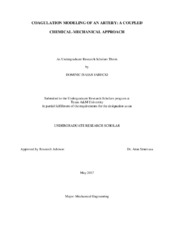| dc.description.abstract | Literature Review
Heart disease is a leading cause of death in developed countries. It typically is a slow killer, with atherosclerosis slowly worsening throughout the course of a patient’s lifetime, often only revealing itself with traumatic circulatory failure such as heart attack or stroke. To combat heart disease in the long term, then, requires not just knowledge of a traumatic event itself, but also the slow progression that leads up to it. To this end, extensive research of the circulatory system has been performed to study blood flow fields formed and their interplay with coagulation phenomena.
The flow behavior of blood is influenced by many factors. Most notably, the mechanical behavior of the blood flow and the blood vessel walls, the chemical composition of the blood, and the presence of geometric irregularities—whether due to genetic defects, injuries, or the addition of man-made objects (for instance stents or LVADs) to treat a particular health issue—make complete analysis difficult. The associated computational cost makes full-scale preventative simulation (perhaps carried out over a lifetime) prohibitive.
Focusing on mechanics based simulations, work with varying degrees of fidelity has been performed, usually with the data of interest including the local blood pressure, wall shear stress, and flow patterns ([1], [2]), and usually limited to studies of arteries.
Early simulations often assumed the arterial wall to be rigid, the blood to be a Newtonian fluid, or both (see [3], [4]), a choice necessitated by the computational challenges of coupled fluid-structure interaction (FSI) and variable viscosity behavior.
Simulations with varying levels of sophistication including details such as patient specific data, three-dimensional models, and fluid-structure interaction (FSI) between the blood and arterial walls ([5], [6], [7]) have been performed, albeit usually limited to a particular blood vessels (such as the carotid or iliac artery bifurcations) exclusively.
Analyses in these works have been predominantly focused on the mechanical behavior of an system whose response does not evolve; that is, stress-strain phenomena in the walls and velocity and stress of the blood flow are investigated in some system with a given (constant) degree of stenosis. In reality, the vascular system is the stage for constant chemical activity, which can alter not only the geometry (for instance increasing clotting in an area and restricting flow) but also mechanical properties such as the local viscosity of the blood and the rigidity of the arterial walls themselves.
Research into the chemical behavior of the coagulation cascade has largely proceeded
separately from the analysis of the mechanical phenomena observed; this is in part due to the
complexity of the models that govern this behavior ([8], [9]).
This difficulty is shown particularly in regards to modeling of platelet action.
Coagulation in the vascular system is effected by synergistic mechanical action of platelets and
chemical reaction of the clotting factors that make up the coagulation cascade. Due to the
immense number of platelets present in blood (roughly 200 000 platelets/ L of blood for a
healthy human adult) they present significant tracking difficulty, and most modeling efforts are limited to blood vessels on the order of capillaries or arterioles to keep the number of platelets manageable (see [10]–[12]). However, most of the important clotting pathologies manifest themselves in larger blood vessels, such as the carotid.
Predictive and diagnostic modeling patient-specific simulation requires that an appropriate balance be struck between accuracy and accessibility and between scope and detail.
Previous work by the authors of this study investigated the consequences of neglecting a non-Newtonian viscosity model, observing how Newtonian and non-Newtonian assumptions affected
the stagnation zone size predicted downstream of a mildly stenosed area in an axisymmetric model of an artery.
The goal of this work is to move towards accounting for the chemorheology of flowing blood, with enough simplification to enable rapid evaluation of the response. This paper assesses the feasibility of a reduced-order model of the coagulation cascade coupled with a stochastic model of platelet motion and species convection, laying groundwork for more detailed simulation and clinical implementation designed to remain computationally tractable for use in large arteries.
Thesis Statement
This research work mathematically characterizes a model of coagulation dynamics, coupling a mechanical flow simulation with a reduced-order model of the coagulation cascade and a stochastic advection/diffusion equation to handle platelet motion and species convection.
The coupled model is demonstrated in a two-dimensional reduction of an artery.
Theoretical Framework
This work relies on the basic principles of fluid mechanics of a continuum; in addition to these, variable viscosity and other unique properties of blood must be addressed through additional equations.
Project Description
This project introduces a simplified framework for modeling coagulation behavior in the vascular system, and demonstrates the response obtained in quiescent flow. Full implementation requires simulation of blood flow models, stochastic convection of active species, use of a set of reduced-order coagulation chemistry equation, and combination of the three models, potentially in a multi-scale set up. | en |


